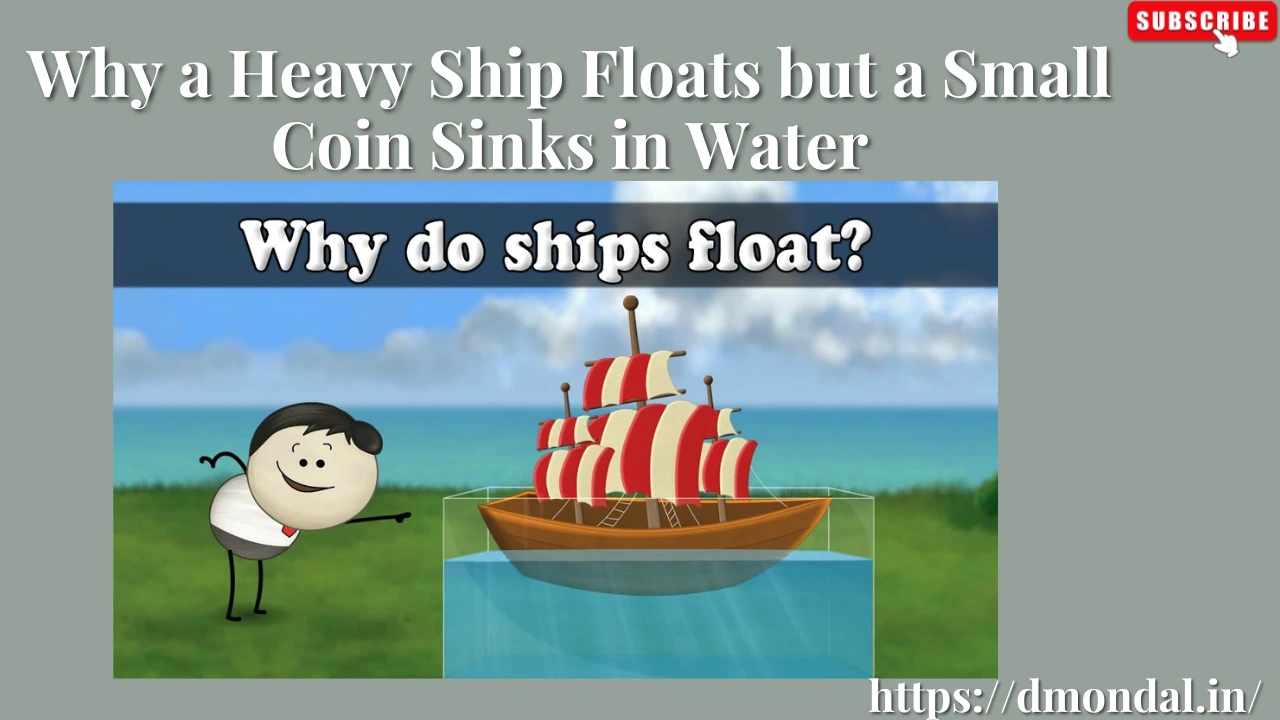Why a Heavy Ship Floats but a Small Coin Sinks in Water
The density of pure water at standard conditions is:
- 1 gram per cubic centimeter (g/cm³)
- 1000 kilograms per cubic meter (kg/m³)
Floating Ships and Sinking Coins – The Secret of Buoyancy
The secret behind floating and sinking is not just weight — it’s density.
Density tells us how heavy something is for its size.
📏 Density Formula
Density=Mass/Volume
- If an object’s density is less than water (1000 kg/m³) → it floats.
- If an object’s density is more than water → it sinks.
🚢 Ship Example Calculation
Let’s assume:
- Ship mass (weight) = 50,000,000 kg (50,000 tons)
- Ship volume (including hollow space) = 70,000 m³
Step 1 – Find density:
Density=50,000,000/70,000
≈714 kg/m³
Step 2 – Compare with water:
- Water density = 1000 kg/m³
- Ship density = 714 kg/m³
✅ Since 714 < 1000, the ship floats.
💰 Coin Example Calculation
Let’s assume:
- Mass of ₹1 coin = 0.00485 kg (4.85 g)
- Volume of coin = 5.5 × 10⁻⁷ m³
Step 1 – Find density:
Density=0.00485/(5.5×10−7)
≈8,818 kg/m³
Step 2 – Compare with water:
- Water density = 1000 kg/m³
- Coin density = 8,818 kg/m³
❌ Since 8,818 > 1000, the coin sinks.
🔍 Key Idea
- A ship’s large hollow shape increases its volume without adding much mass → density becomes less than water.
- A coin is small and solid, so its density is much greater than water.
📊 Density Comparison Table
| Object | Mass (kg) | Volume (m³) | Density (kg/m³) | Float/Sink |
|---|---|---|---|---|
| Ship | 50,000,000 | 70,000 | 714 | ✅ Floats |
| Coin | 0.00485 | 5.5×10⁻⁷ | 8,818 | ❌ Sinks |
The density of air at standard conditions is:
The density of air depends on temperature, pressure, and humidity, but at standard conditions it is approximately:
- 1.225 kg/m³ at sea level, 15°C, and 1 atmosphere pressure
- In grams per liter: 1.225 g/L
Alright — let’s compare air vs. water in terms of heaviness (density) in a clear, simple way.
⚖ Density Comparison
| Substance | Density (kg/m³) | Which is Heavier? |
|---|---|---|
| Air (sea level, 15°C) | ~1.225 | ❌ Very light |
| Water (4°C) | 1000 | ✅ Much heavier |
🧠 What This Means
- Water is about 800 times heavier than air for the same volume.
For example:- 1 cubic meter of air = ~1.2 kg
- 1 cubic meter of water = ~1000 kg
- That’s why you can easily wave your hand in air but not in water — water has much more mass in the same space.
🌊 Why This Matters for Floating
- A ship floats because air inside its hull reduces its average density to less than water.
- Even though the steel part is much denser than water, the big hollow space filled with light air keeps the overall density low enough to float.
- A coin doesn’t have air inside — so its density stays higher than water, and it sinks.
If you want, I can make a visual graphic showing
💨 1 m³ of air vs 🌊 1 m³ of water,
so people can instantly see how much heavier water is than air.
Basic Volume Formulas
The formula for volume depends on the shape of the object.
Here are the most common ones:
📏 Basic Volume Formulas
- Cube
V=a3
where a = side length
- Rectangular Box (Cuboid)
V=l×w×h
where l = length, w = width, h = height
- Cylinder
V=πr2h
where r = radius, h = height
- Sphere
V=(4/3) x πr3
- Cone
V=(1/3) x πr2h
💡 General Idea:
Volume is the amount of space an object occupies, usually measured in m³ (cubic meters) or liters.
Here’s a complete table of volume formulas for the most common 3D shapes (since 2D shapes don’t have volume, they have area).
📊 Table of Volume Formulas – 3D Shapes
| Shape | Formula for Volume VVV | Variables |
|---|---|---|
| Cube | V=a3 | a = side length |
| Cuboid / Rectangular Prism | V=l×w×h | l = length, w = width, h = height |
| Cylinder | V=πr2h | r = radius of base, h = height |
| Cone | V=(1/3) x πr2h | r = radius of base, h = height |
| Sphere | V=(4/3)πr3 | r = radius |
| Hemisphere | V=(2/3) x πr3 | r = radius |
| Triangular Prism | V=(1/2) x b x h × L | b = base of triangle, h = height of triangle, L = length of prism |
| Pyramid (Square Base) | V=(1/3) x b2h | b = base side length, h = height |
| Pyramid (Rectangular Base) | V=(1/3) x lwh | l = length, w = width, h = height |
| Ellipsoid | V=(4/3)πabc | a,b,ca, b, ca,b,c = radii along x, y, z axes |
| Torus (Donut Shape) | V=2π2Rr2 | R = distance from center to tube center, r = radius of tube |
📏 Units of Volume
- Cubic meters (m³) – for large objects
- Liters (L) – for liquids (1 m³ = 1000 L)
- Cubic centimeters (cm³) – small objects (1 cm³ = 1 mL)
Read more blog post: Click here
